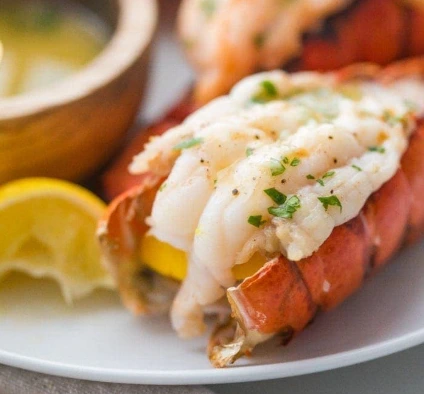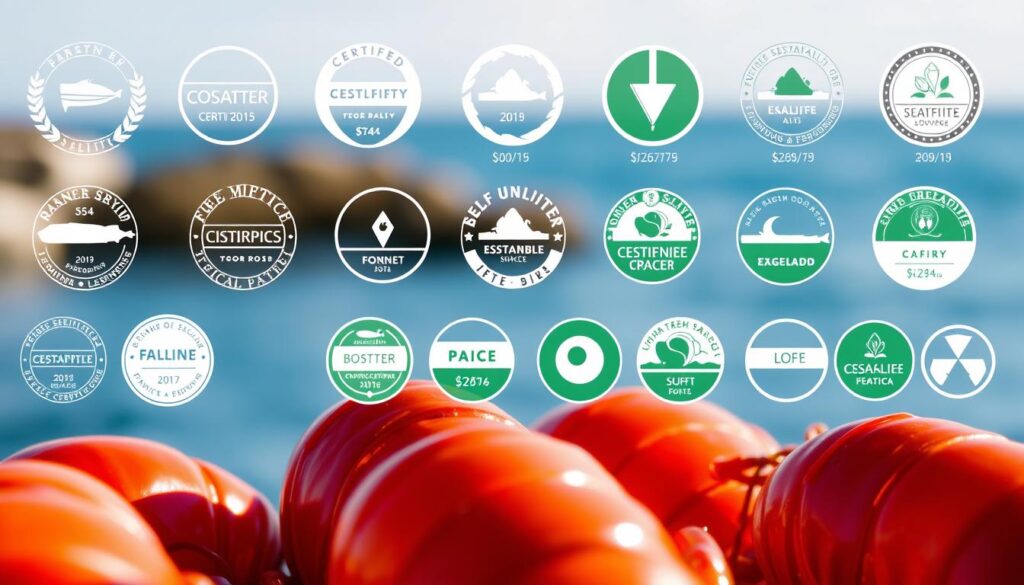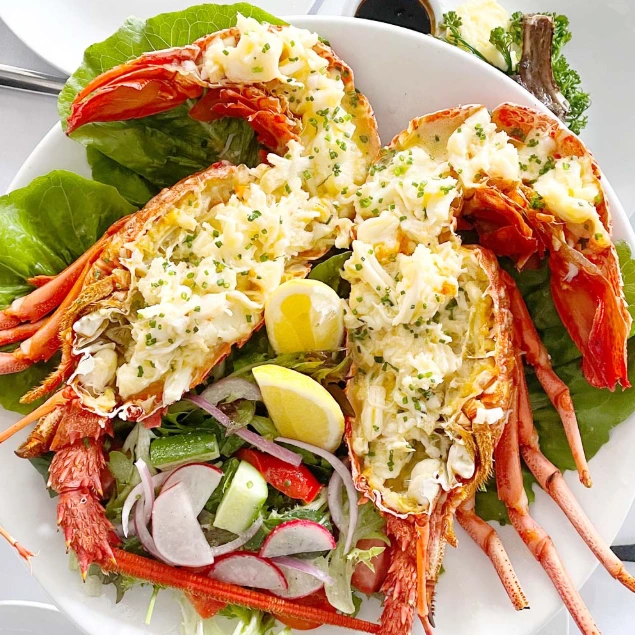Imagine a bustling New England port in the 18th century. Lobster was so common, it even fed prisoners and servants. Now, those same lobster tails are a sign of luxury, found on fine dining tables everywhere. They’ve gone from simple food to a gourmet favorite, known for their tender, buttery taste.
These tails are more than just a meal. They tell a story of history, skill, and indulgence.
Key Takeaways
- Lobster tails rose from coastal survival food to luxury seafood staples.
- Rich in protein and low in fat, they offer heart-healthy omega-3s.
- Easy to cook compared to whole lobsters, making them ideal for home chefs.
- Prime examples of premium lobster, with Maine and Caribbean varieties leading the market.
- Perfect for pairing with wines and sides to elevate any dinner occasion.
The Exquisite World of Lobster Tails
Step into the world of lobster tails, where culinary luxury meets unmatched flavor. The lobster tail meat is a seafood delicacy. It’s prized for its tender texture and rich lobster flavor. This cut comes from the lobster’s tail, offering the largest and most sought-after portion.
Lobster tails come from cold Atlantic waters and are loved worldwide. In New England, they’re boiled in traditional boils. French chefs pair them with butter sauces. Asian cuisines turn them into spicy stir-fries, showing their versatility. The lobster flavor suits every taste, making it a favorite in kitchens everywhere.
“The key to great lobster is respecting its natural sweetness.” — Chef Emeril Lagasse
Health-conscious diners enjoy lobster tails. They’re low in fat and high in protein, making them a guilt-free treat. Their delicate lobster tail meat takes on flavors well. Whether grilled, baked, or steamed, they stay tender and moist.
- Global Appeal: From Maine to Paris, lobster tails dominate gourmet menus.
- Health Benefits: High in vitamin B12 and zinc.
- Texture: Flaky, tender meat ideal for any dish.
Exploring this seafood delicacy reveals its journey from ocean to plate. Each bite offers a sensory experience. The crisp outside and buttery inside define culinary luxury. Ready to master it? Let’s dive into how to prepare and enjoy this treasure in the next sections.
Types of Lobster Tails You Should Know
Choosing the right lobster tail starts with understanding their origins and characteristics. Here’s how to navigate the options available to you:
Cold Water Lobster Tails
Cold water lobster comes from chilly North Atlantic regions like Maine and Canada. These tails, often labeled asMaine lobster tails, have tender, sweet meat prized by chefs. Look for varieties from New Zealand or South Africa too. Their firm yet delicate texture works best in dishes where flavor shines through.
Warm Water Lobster Tails
Warm water lobster thrives in tropical seas around the Caribbean, Brazil, and Florida. These tails likespiny lobsterlack claws but offer dense, meaty tails. They’re more affordable and widely available year-round. Their hearty texture holds up well on the grill or in sauces.
Maine Lobster vs. Spiny Lobster
- Maine lobsters have claws and live in cold water
- Spiny lobsters lack claws but have larger tails
- Cold water varieties cost more but deliver melt-in-your-mouth texture
- Warm water tails are budget-friendly and versatile
Lobster Tail Sizes and What They Mean
Sizes matter when selecting for your recipe:
- Small (4-6 oz): Ideal for appetizers or smaller portions
- Medium (8-10 oz): Versatile for a range of dishes
- Jumbo (14-16 oz): Perfect for main courses or sharing
- Colossal (18+ oz): Luxe options for special occasions
Knowing these distinctions helps you pick the right lobster tail for your cooking goals. Always check for clear, unblemished shells and plump tails to ensure quality. Seasonal availability varies—cold water peaks in summer while warm water stays consistent year-round.
Nutritional Benefits of Lobster Tails
Choosing lobster tails is a smart health choice. It’s packed with protein, just like meat, but has less fat. A 6-ounce serving has about 28 grams of protein. This helps build and repair muscles without adding too many calories.
Lobster is also low in fat and carbs. It’s full of omega-3 fatty acids, which are good for your heart and brain. It’s also rich in vitamins and minerals like vitamin B12, zinc, and selenium. These nutrients support your overall health.
- Protein powerhouse: High-quality protein for muscle maintenance
- Heart-healthy fats: Omega-3s with minimal saturated fat
- Vitamins & minerals: B12, zinc, and selenium for overall wellness
“Lobster is a standout in healthy seafood choices, offering nutrients without the guilt.”
Enjoy lobster without the guilt by eating it lightly. Try steaming or grilling it. Lobster is a great choice for any meal, whether it’s for a family dinner or a special event.
Preparing Lobster Tails Before Cooking
Mastering lobster preparation makes your meal top-notch. Follow these steps to avoid mistakes and keep the meat tender and flavorful.
Thawing Frozen Lobster Tails Properly
If your tails are frozen, thaw them safely. Put them in the fridge overnight or thaw in cold water for 30 minutes. Never use hot water—it can mess up the texture and safety.
Butterflying Techniques
To cook and present evenly, butterfly lobster tail by cutting lengthwise along the top shell. Use kitchen shears to spread the tail flat. Secure edges with toothpicks before cooking.
Splitting and Cleaning
Cleanliness is crucial. To how to clean lobster tails, split the tail lengthwise but keep the underside intact. Remove the veinous strip and rinse under cold water.
Tools You’ll Need
- Kitchen shears (like OXO Good Grips)
- Sharp knife or chef’s blade
- Toothpicks for securing
- Seafood picks for serving
Quality seafood tools make prep easier. Avoid plastic utensils—they can crack shells. Invest in durable kitchen gear for the best results.
“Butterflying ensures even heat distribution and stunning presentation.” — Chef Marco Conti
Cooking Methods for Perfect Lobster Tails
Learn the secrets of how to cook lobster tails with these expert methods. Each technique brings out the best in your lobster tails. Let’s explore the best ways to prepare this delicacy.
Boiling vs. Steaming
Boiling is quick but may lose flavor. On the other hand, steamed lobster tails keep their natural sweetness. For steaming, place tails in a basket over boiling water for 8–10 minutes. Boil for 6–8 minutes. Both methods require checking for opaque, white meat.
Grilling for Smoky Flavor
Fire up the grill for a grilled lobster tail masterpiece. Butterfly the tail, brush with olive oil, and grill for 5–7 minutes per side. Try a garlic butter marinade for extra depth.
Baking and Broiling Techniques
Bake at 400°F for 12–15 minutes, or broil for a golden crust. For broiled lobster, place tails 3–4 inches from the heat and baste with melted butter. Avoid overcooking—check the internal temp reaches 140–145°F.
Sous Vide for Precision
Sous vide lobster ensures even doneness. Cook in a water bath at 135°F for 1–2 hours, then finish with a quick sear. As culinary experts note, “Sous vide eliminates guesswork for consistent results.”
Delicious Lobster Tail Recipes to Try at Home
Turn fresh lobster tails into unforgettable meals with these lobster tail recipes. Whether you love classic dishes or new flavors, these ideas make cooking lobster at home easy.

- Classic Butter-Poached Lobster: Simmer tails in a lobster tail butter sauce with garlic and thyme. Serve with drawn butter and lemon wedges for a timeless lobster dinner idea.
- Garlic Herb Grilled Delight: Marinate butterflied tails in olive oil, rosemary, and minced garlic before grilling. Pair with roasted vegetables for a summer feast.
- Easy Lobster Recipes: Toss cooked lobster meat into pasta dishes like linguine with white wine cream sauce. This makes luxurious meals more affordable.
- Spicy Asian Twist: Marinate tails in soy sauce, ginger, and chili oil before steaming. Garnish with sesame seeds and scallions for an exotic touch.
“The key to great lobster is simplicity—let the ingredient shine,” says Chef Marco Conti of The Blue Crab Bistro. “Balance bold flavors without overwhelming its natural sweetness.”
Adjust cooking times based on tail size—jumbo tails may need 8-10 minutes per side, while smaller ones cook faster. Try gourmet lobster dishes by adding truffle oil or pairing with crisp salads. Whether hosting a dinner party or a cozy family meal, these lobster dinner ideas show you can achieve restaurant-quality results at home. Start with easy lobster recipes and build confidence to tackle more complex preparations. Your kitchen’s next masterpiece awaits!
Wine and Side Dish Pairings for Your Lobster Tails
Make your lobster tail meal special with the right wine and sides. Whether you grill or bake, the perfect pairings will make each bite better.
White Wine Selections
For white wine with lobster, choose crisp ones. Chablis’s minerality or a citrusy Sancerre pairs well. An unoaked Chardonnay won’t overpower the lobster’s taste. Look for Domaine Leflaive or Louis Jadot for top picks.
Champagne and Lobster
“Sparkling wines’ acidity lifts lobster’s sweetness perfectly,” says Master Sommelier Emily Roberts. “Try a dry brut like Veuve Clicquot or budget-friendly Prosecco.”
Pair champagne and lobster with light dishes like steamed tails. This lets the bubbles enhance the meal.
Vegetable Side Dishes
- Asparagus with lemon zest adds brightness.
- Grilled zucchini or eggplant with herbs.
- Romanesco broccoli roasted with garlic.
Keep vegetable sides simple. This way, they won’t overshadow the lobster’s taste.
Starch Accompaniments
Try drawn-butter risotto or herbed mashed potatoes for a good match. Crusty sourdough bread is great for soaking up juices. But, avoid heavy sauces that might clash with your wine choice.
How to Source Sustainable Lobster Tails
Choosing sustainable lobster helps our oceans and fishing communities. Look for labels like the Marine Stewardship Council (MSC) or Monterey Bay Aquarium’s Seafood Watch. These labels mean the lobster was caught in a way that’s good for the sea.

- Look for MSC-certified sustainable lobster products in stores or online.
- Check Seafood Watch’s regional guides for environmentally friendly lobster options in your area.
- Ask suppliers about lobster fishing practices—reputable vendors will share details about conservation efforts.
Maine’s lobster fisheries use special traps to help young lobsters. Canadian, Australian, and New Zealand fisheries also follow strict seafood sustainability standards. When buying online, choose companies that clearly show where their lobster comes from.
Seasonal buying is important too. Buying lobster when it’s in season helps avoid overfishing. Always ask where the lobster was caught and if it’s wild or farmed. Wild-caught lobster from certified places is usually better for the environment than farmed lobster.
Every time you buy lobster, you help shape the future of our oceans. By picking certified, local, and responsibly caught sustainable lobster, you enjoy great food while helping the sea stay healthy for the future.
Storing and Handling Your Lobster Tails
Proper storage keeps your lobster tails fresh and safe. Follow these steps to ensure quality and safety from purchase to plate:
Refrigeration Guidelines
Keep lobster tails at 32–38°F. Wrap them in plastic wrap, then in an airtight container. Use within 1–2 days. Here are some tips for storing lobster tails:
- Wrap tails tightly in plastic before refrigerating
- Store on a shelf, not the door, to maintain consistent coldness
- Check packaging for specific fresh lobster storage instructions
Freezing for Later Use
Freezing lobster tails keeps them fresh. Double-wrap in plastic and foil, then in a freezer-safe bag. Label with dates. Here are some tips for freezing lobster tails:
- Freezer temp should stay at 0°F or below
- Use within 3 months for best texture and flavor
- Thaw in the fridge 24 hours before cooking
Signs of Freshness
Check these before buying or using:
- Firm, springy meat when pressed
- No dark spots or slimy texture
- Faint ocean scent—not ammonia or fishy odor
- Shells should be intact with no cracks
Food Safety Considerations
Seafood safety is crucial. Always:
- Wash hands and surfaces before and after handling
- Separate raw tails from other foods to avoid cross-contamination
- Cook within 1–2 days if refrigerated
- Discard if meat smells bad or looks discolored
Common Mistakes When Cooking Lobster Tails
Mastering lobster tail cooking means avoiding common mistakes. These errors can make the lobster tough and flavorless. Here’s how to avoid these mistakes and cook lobster perfectly every time.
“The key is timing. Overcooking destroys the delicate flavor,” says Chef Marie Claire, a seafood specialist.
- Overcooking: Cook no longer than 12-15 minutes. Overcooked lobster loses moisture, becoming tough. Check doneness when the meat reaches 140°F (60°C).
- Improper Thawing: Thaw tails in the fridge, not warm water. Quick methods like microwaving damage texture, leading to dry meat.
- Skipping Prep Steps: Butterflying ensures even cooking. Neglecting to split and clean tails causes uneven results.
- Temperature Control: Grilling too high or baking at temperatures above 400°F (200°C) dries out meat. Use a meat thermometer to monitor.
To prevent tough lobster, balance heat and timing. Season lightly with sea salt and butter to enhance sweetness without hiding flavor. Always serve tails hot to keep texture. Follow these tips to avoid a rubbery lobster tail and enjoy top-notch results at home.
Conclusion
Now you know how to make your own luxury seafood experience with lobster tails. You’ve learned about choosing the best cold-water varieties and how to butterfly them. Your lobster tail skills will make every meal special.
Whether you’re grilling for a simple dinner or making a fancy sous vide lobster dinner, your kitchen can be as good as any restaurant. Cooking lobster at home is not just about convenience. It’s about learning to cook seafood like a pro.
Start with easy recipes like steaming with butter, then try new flavors. Always store your lobster right and choose sustainable options. This way, you’ll not only enjoy great meals but also help the ocean.
Imagine serving lobster tails with champagne or a citrus herb sauce. It’s more than cooking; it’s celebrating tradition and creativity. This guide will help you create unforgettable meals or enjoy quiet nights in.
With every lobster tail you cook, you’re mastering the art of seafood cooking. You’re making every dinner special. So, get ready to start. Stock your pantry, fire up the grill, or preheat the oven. Your lobster tail journey begins now.
Use your new skills to make your meals both flavorful and impressive. You don’t need a fancy restaurant to enjoy a gourmet lobster dinner. The ocean’s best is just a few steps away, and your kitchen is the perfect place to enjoy it.

